The French Renault FT 17
This working restored WW1 French Renault FT-17 Tank, that fought in the 1940 Battle of France, can be found at the French Tank Museum in Saumur in the Loire Valley. The Museum is called Musée des Blindés ou Association des Amis du Musée des Blindés, 1043, route de Fontevraud, 49400 Saumur, France www.museedesblindes.fr . The word Blindés means armoured.
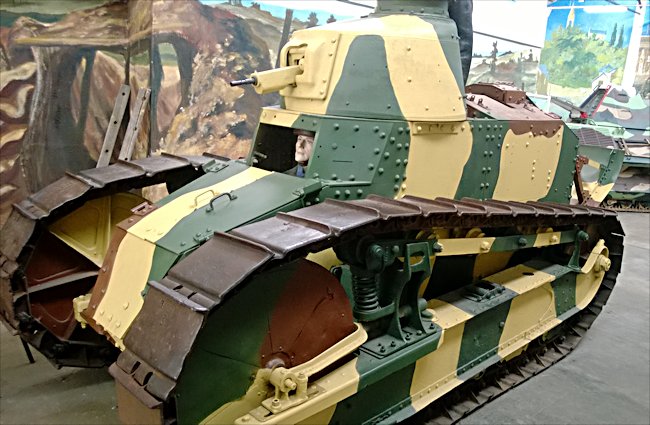
WW1-WW2 French Renault FT 17 Tank. This tank was recovered by French Military Special Forces in Afghanistan and brought back to France in 2007. It originally carried a 37mm gun, but was restored with a machinegun from one of the 2 FTs in running condition.
Designed by the French General Estienne, the Renault FT 17 was the worlds first combat capable tank with a revolving turret. For crossing wider trenches a spur was fitted at the rear. With over 3,000 Renault FT17 tanks produced it spearheaded the late 1918 French offensive operations and helped in the final victory over the Germans. It was only given the number 17 to its name after the war. It referred to the date it entered French Military service.
As of 1931 the original 8mm Hotchkiss 1914 machine gun was replaced with a 7.5mm Reibel machine gun as fitted to this tank. It is so strange to think that the French Army of 1940 were still using WW1 tanks. They had 534 Renault FT 17 tanks in active service at the start of 1940. All armed with machine guns. None of them had the 37mm Puteaux cannon.
Renault FT tanks equipped eight French Army Battalions as infantry support weapons. Each Battalion was issued with sixty three of these light tanks as seen in the photographs on this page. Three independent companies were issued with 10 Renault FT17 tanks.
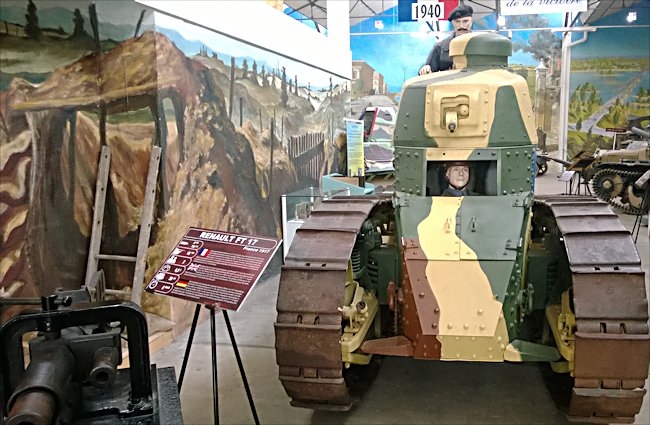
This tank only had a two man crew. It was more comfortable for the commander to sit on the rear of the tank when not involved in combat.
In 1940 just before the battle of France, 1,600 Renault FT tanks were still in operational use by the French army, making up half of the French tank fleet. This was a ridiculous situation as the tank was already obsolete. It was outgunned by the enemy vehicles and it did not have enough protective armour.
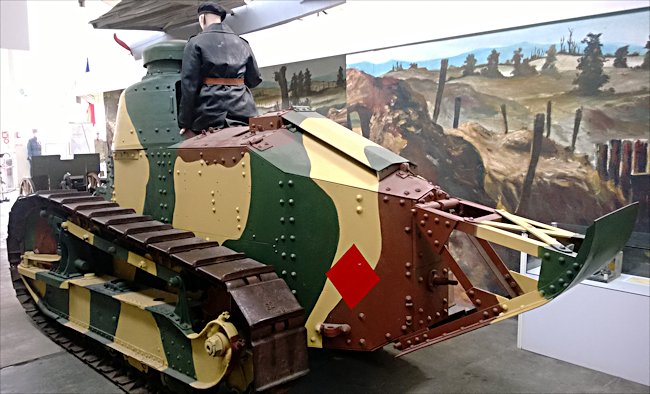
Each Renault FT 17 Tank was fitted with a rear spur to help it cross wide trenches.
The developement history of the Renault FT tank
The first two attempts the French army made a building an effective tank during World War I were not very successful. These were the Schneider CA 16 and Saint Chamond French Heavy Tank. They suffered from poor aiming angles and an inability to traverse enemy infantry defensive trenches successfully.
Louis Renault used the development facilities of his company to try and solve these drawbacks. After overcoming numerous bureaucratic red tape. He was finally commissioned by Minister Estienne to proceed with developing a new French battle tank in January of 1917.
The Renault company delivered a world first. A tank that had a turret that could traverse 360°. Now the tanks hull did not have to turn in the direction of the enemy to open fire on them. It would form the templated for all tank the followed it. It was such a good design that it was still in operational use in 1939. The driver was positioned at the front of the vehicle. Behind him was the main battle compartment. The engine was placed at the rear of the vehicle.
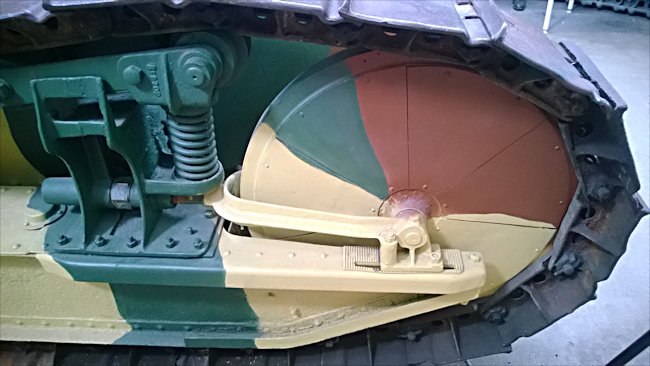
Front track wheel suspension spring was exposed and easily damaged by artillery fire on a French Renault FT 17 Tank
There were only two members in the crew, unlike other World War I tanks whose crew compliments range from 8 to 18 soldiers. The commander-gunner was positioned behind the driver and took up a semi-sitting position inside the battle compartment with his head in the turret. He used a wide strap suspended from the side of the vehicle as a seat.
The driver got into his seat through an armoured hatch front. This was also his escape hatch. The commander had a hatch in the rear of the turret. This was also his emergency escape door. Behind the commander by his legs was the starting handle for the engine. Each morning to start the vehicle he had to bend down in that cramped battle compartment and keep cranking the handle until the engine started.
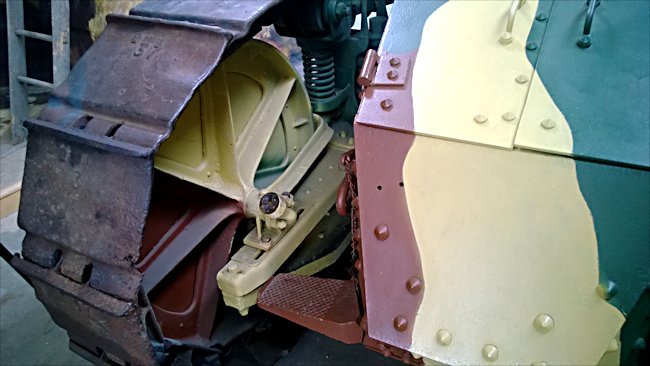
The suspension system on the Renault FT 17 Tank was a weak spot as it could easily be damaged by large artillery splinters.
The new Renault tank was a light tank compared to the large assault tanks used by the British. They complemented each other. On 18th July 1918 the French deployed light tanks en masse the first time during an assault. Nearly 350 tanks were deployed, 245 of them were Renault FT light tanks. They participated in the battle of Soissons.
They were deployed as a wave of armour that could overpower enemy resistance. They managed to break through the German front line and continue to attack his rear supply lines. The French infantry followed the tanks breakthrough.
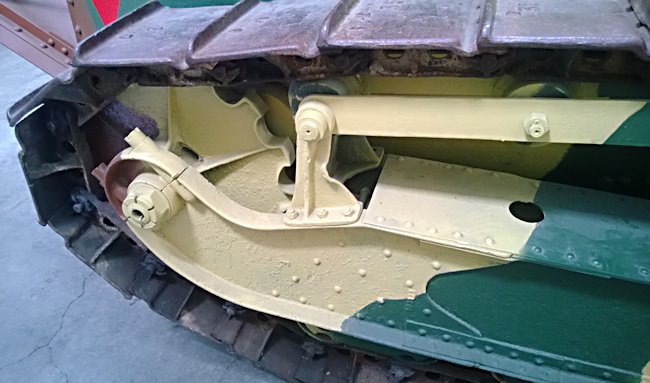
Changing damaged rear track wheels on the Renault FT 17 Tank was labour intensive. The ability to make quick battlefield repairs were not taken into consideration when the tank was designed.
Unfortunately victories like the battle of Soissons gave the French army a false sense of military superiority. The Renault FT had shown that it can win battles with the help of the infantry. TAe French High Command could see no reason why the general design of the tank should be changed. They were confident in the Renault FT tanks abilities. Apart from replacing the machine gun with a 37 mm Puteaux SA18 short-barreled Gun, not a lot else was changed.
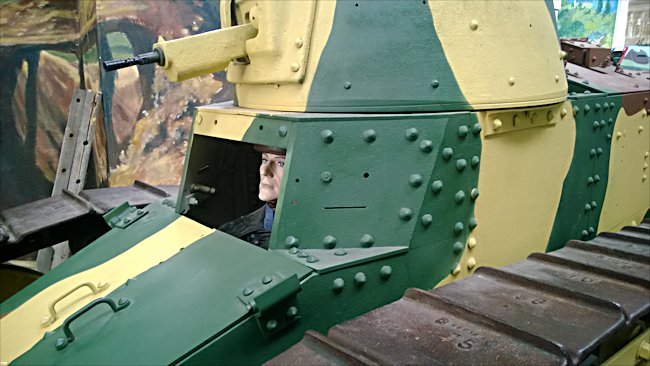
The driver's hatch and position on the Renault FT 17 Tank. The driver's face area hinged hatch is missing.
What should have happened was that all the Renault FT tanks were scrapped and resources put into producing more tanks like the char B1-bis. This was not going to happen because the French generals were only interested in fortifying the Maginot line that ran along the border with Germany. They could not see why they should divert resources into building up an armoured tank force when the defences built into the Maginot line were believed to be so strong that no enemy could penetrate it.
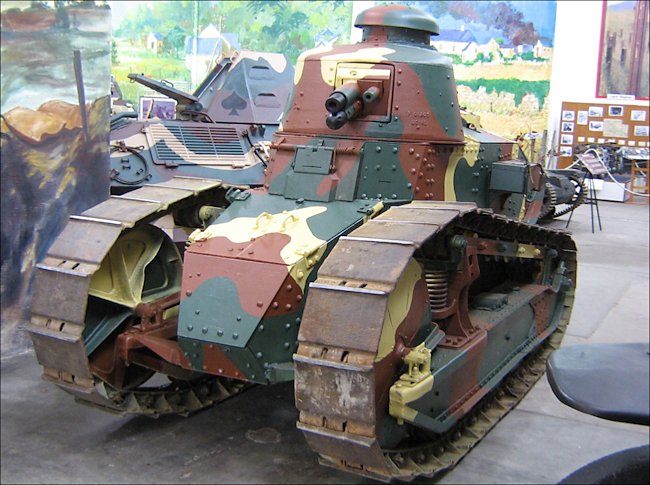
This Renault FT tank was originally armed with a a machinegun, but was fitted with a 37mm gun from a Renault FT recovered from Afghanistan. It is in a running condition.
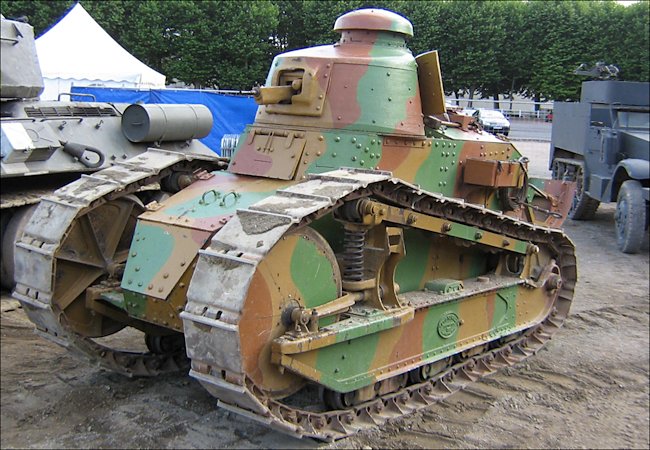
This Renault FT tank still has the manufacturer’s plate, the SN is 6024.18. It is in a running condition.
Where can I find other preserved Renault FT Tanks?
- Prototype - Bovington Tank Museum, UK
- The Weald Foundation, UK
- Tellevik Kystfort, Norway
- Rogaland Krigshistoriske Museum, Stavanger, Norway
- Wehrtechnische Studiensammlung Koblenz, Germany
- Nationaal Militair Museum, Soesterberg, Netherlands
- Netherlands War Museum, Overloon, Netherlands
- Royal Museum of the Armed Forces, Brussels, Belgium
- 3x Musée des Blindés, Saumur, France
- Musée de l’armée, Invalides, Paris, France
- Fort de Seclin, near Lille, France
- Aquatic Maginot Line Memorial Way, Franc
- Renault Trucks Défense headquarters, Versailles-Satory, France
- Musée de la Grande Guerre du Pays de Meaux, Meaux, France
- ondation Marius Berliet, Le Montellier, near Lyon, France
- Association France 40 véhicules, Fismes, France
- Sammlung Historische Panzer, Thun, Switzerland
- El Goloso Museum, Madrid, Spain
- Academia General Militar (AGM), Zaragoza, Spain
- Centro de Mantenimiento de Sistemas Acorazados n°2, Segovia, Spain
- Academia de Infanteria, Toledo, Spain
- Finnish Armour Museum, Parola, Finland
- Polish Army Museum, Warsaw, Poland
- Kalemegdan Military Museum, Belgrade, Serbia
- Muzeul Militar National, Bucharest, Romania
- Bamako, Mali
- Kubinka Tank Museum, Russia
- Aberdeen U.S. Army Ordnance Museum, MD, USA
- Fort Meade, MD, USA
- US Army Heritage and Education Center, Carlisle, USA
- National Infantry Museum, Fort Benning, GA, USA
- National Armor and Cavalry Museum, Fort Benning, GA, USA
- National WW1 Museum, Kansas City, MO, USA
- Jackson Barracks Military Museum, New Orleans, LA, USA
- Escola de Material Bélico (EsMB), Vila Militar, Rio de Janeiro, Brazil
- Parque Regional de Manutenção/1, Vila Militar, Rio de Janeiro, Brazil
- Museu Histórico do Exército (Conde de Linhares), São Cristóvão, Rio de Janeiro, Brazil
- Centro de Instrução de Blindados, Santa Maria, Brazil
- Academia Militar das Agulhas Negras (AMAN), Resende, Brazil
- 2º Regimento de Carros de Combate, Pirassununga, Brazil
- Museu Eduardo André Matarazzo, Bebedouro, Brazil
- Australian War Memorial, Campbell ACT, Australia
- Wreck - Kongsfjord, Northern Norway
- Wreck - André Becker Collection, Belgium
- Wreck - Adam Rudnicki Collection, Poland
- Wreck - Museum of the American G.I., College Station, TX, USA
- Soviet built - Kubinka Tank Museum, Russia
- Soviet built - Nizhny Novgorod, Nizhny Novgorod Oblast, Russia
- Renault FT TSF - The Weald Foundation, UK
- Renault FT TSF - Musée des Blindés, Saumur, France
- Renault FT TSF - Fort du Zeiterholz, Entrange, France
- Renault FT TSF - Unknown Location in Poland
- Renault FT TSF - Musée des Blindés, Saumur, France
- Renault FT TSF - Musée des Blindés, Saumur, France
- 2x replicas - Foundation of the History of Polish Armoured Fighting Vehicles, Toruń (Poland
- Source - Pierre-Olicer Buan Surviving Panzers http://the.shadock.free.fr/Surviving_Panzers.html
WW2 tank books

